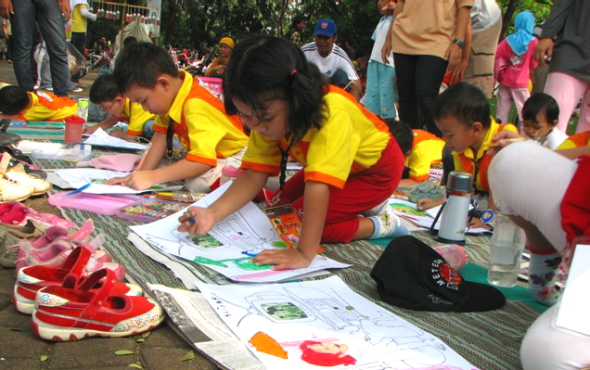Indonesians act on their concerns about the new tele-visual environment
Edwin Jurriens
A peaceful demonstration rounds the Hotel Indonesia roundabout incelebration of the Day Without TelevisionYayasan Pengembangan Media Anak |
‘The Day Without TV’ is not anti-TV exclaims a flyer promoting Indonesia’s fifth annual day without television, which took place this year on 25 July 2010. In the event, which consists of press conferences and several days of peaceful demonstrations, seminars and children’s activities in various cities, Indonesian children and their families are urged to abstain from watching television for a whole day. This is meant to encourage them to reflect on - and possibly change – their television watching habits.
Media expansion
Since its inception in 2006, the Day Without TV has been organised by the Foundation for the Development of Children’s Media (YPMA), one of the most active organisations in promoting media literacy in Indonesia. Bobby Guntarto, co-founder of YPMA and initiator of the event, explains that its purpose is encourage the public to think about what kind of television watching is in children’s best interests. What kinds of programs help kids to develop and expand their horizons?
Guntarto’s interest in media literacy must be understood in a context in which Indonesian print and electronic media have both vastly expanded. In the period since the fall of the New Order in 1998, commercial television with a national reach has expanded from 5 to 10 stations. The number of commercial regional television stations with restricted provincial reach has also increased. The expansion of television has prompted stiff competition among stations for audience share. This, in turn, has led to an abundance of programs boasting ‘juicy’ or sensational content dealing with violence, sexual matters, and unconventional religious practices. Some critics, including those at YPMA, are concerned about children’s exposure to such topics.
The impact of television on children came to national attention in November 2006, when a 9-year old boy, Reza Ikhsan Fadillah, died in Bandung after he was injured in a brawl sparked by children imitating fighting scenes from SmackDown, a US wrestling show broadcast on Indonesian commercial television. The establishment of YPMA in Jakarta, with funding from the United Nations Children’s Fund, preceded this event by two years. Since the boy’s death – a national news item for some days – many of YPMA’s founding ideals concerning media literacy have attained increasing public currency.
Qualitative ratings
‘It is a really big challenge to be a parent these days… TV is treated too much like a friend of the family, but more often it’s like a monster in one’s own house… Parents are very much aware of their inability to limit their children’s viewing to a selection from all the TV programs on offer’, writes Iga Mawarni, professional singer and mother of an 8-year-old boy, in a letter to Kidia, YPMA’s bimonthly publication. As well as providing a forum for discussion among YPMA supporters, every issue of Kidia features the organisation’s qualitative ratings of various media products directed at children. These ratings provide an alternative to those provided by the influential media research company, Nielsen Audience Measurement, which collects only quantitative data.
The negative impact television can have on children came to national attention in 2006 when a young boy died in Bandung after imitating scenes from a US wrestling show
Bobby Guntarto observes that television, as the main source of family entertainment, is often consumed indiscriminately for many hours a day, and that broadcasting regulations and their implementation are still weak. One of YPMA’s most frequently published recommendations is that two hours of television a day be the maximum for younger viewers. However, the organisation’s own research reveals that this is well below the average daily television viewing by children and teenagers in urban centres.
According to Guntarto, the key to developing a sustainable television culture in Indonesia is media education. His organisation’s main goals are to protect children against negative media influence, to strengthen the role of parents and teachers in guiding children’s interaction with the media, and to campaign for improvement in the quality of children’s media. These ideals are enshrined in the United Nations Convention on the Rights of the Child (UNCRC), to which Indonesia is a signatory. Yet these cornerstones of children’s media literacy have only recently appeared on the agenda of a few key national bodies, such as the National Child Protection Commission (KOMNASPA) and the Indonesian Broadcasting Commission (KPI), and are yet to be reflected in Indonesian political and social life more generally.
 |
Children participate in the Day Without Television by taking part in drawing and colouring competitionsYayasan Pengembangan Media Anak |
According to YPMA’s own research data, the percentage of ‘safe’ children’s program on Indonesian television has risen from 15 per cent in 2006 to more than 50 per cent in 2010. Guntarto and his colleagues are not yet satisfied with these results, and aim at a more sustainable and systematic way of spreading media education through intensified collaboration with schools and training programs for teachers. Future activities may also include political lobbying for the improvement of broadcasting regulations and their implementation. For the moment, however, YPMA’s focus is on educating the parents and their children themselves, since both the government and the television broadcasting industry are so resistant to change. It is this resistance that keeps expectations low about the possibility of transforming the media environment and gives Indonesians no option other than to turn off their televisions once in a while.
Edwin Jurriens (E.Jurriens@adfa.edu.au) is a lecturer at UNSW at ADFA in Canberra.












